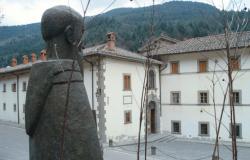Within the numerous exhibitions that mark the Biennale season, some American presences coincide in Venice, which, in different ways, represent eros and its power.
At the Procuratie Vecchie (until 24 November) Robert Indiana is on stage, with an exhibition entitled The Sweet Mystery and curated by Clare Lilley, with the Yorkshire Culture Park. The artist, who passed away in 2018, was a central figure in the world of pop production, especially for the famous and much imitated Love series, which gave him fame and was often imitated. The sequence that gives the exhibition its title, in the artist’s words, was born from the first (and shocking for him) reading of the I Ching, from a Ginko biloba leaf (“which was my Ying and my Yang, but in very Western key and, dangerously in oil on paper, a means of expression that is not permanent”).
The rounded shapes, the recurrences of colors that are variations of the yellow, favored by the artist (with a sequence of browns and ocher), the sculptures with wheels bearing the writing, Soul, are monuments to desire in all its forms. In the background the passion for the poetry of Hart Crane, master of the representation of the metropolitan existential disaster in the lighting of White Buildings (1926), who committed suicide at a young age. The bright colors introduce terms from metropolitan life, such as Hardrock, and fragments of loves with companions of a night or a longer time: “he is a tiger, he is a star, he is a ruby, he is a king”. Eros also changes the features of the world of fathers and mothers, represented scantily clad, wearing only part of their clothes, in a diptych created between 1963 and 1966. In short, as one work says, 2 in the form of a rhombus, Love is god , a capricious deity, who also causes names to change, such as Indiana, adopted in 1958, in place of the more predictable Clark.
Also in Venice, in the new space at Palazzo Donà Brusa in Campo San Polo, Tommaso Calabro, who had already highlighted himself with some happy exhibitions in Milan (for example on Leonor Fini), proposes the first exhibition of Harold Stevenson , until July 27th. The American artist, who also passed away in 2018, had worked for a long time in the lagoon city since the 1960s: this stay is the focus of the exhibition, in which interest returns to Alexandre Iolas, an extraordinary gallery owner who crossed the world aesthetic of the 20th century, with a very personal profile, which supported the artist’s work together with Iris Clert. The pictorial works are details of male bodies, sometimes with references to the world of Greek classicism. The entrance staircase to the exhibition space is adorned with marble phalluses, and the figures also return in glass, in the productions created with one of Murano’s historic brands, Cenedese, in the 1960s and 1970s.




